Xoi Types: A Complete Guide to Vietnamese Sticky Rice

Vietnam is a country rich in culinary traditions. Among its many gastronomic treasures, one dish stands out for its simplicity and versatility. That dish is xoi, or Vietnamese sticky rice.
Xoi is a key part of Vietnamese food. It comes in many types, both sweet and savory. You can find it in street food stalls, markets, and special xoi shops across the country.
Xoi is not just a tasty food. It shows Vietnam's farming history. It highlights how important rice is to the country's economy and culture.
In this guide, we will look at the different types of xoi, why they are important in culture, and how they are made. This guide is for food lovers, travelers going to Vietnam, or anyone interested in Vietnamese food. It will give you a complete introduction to xoi.
So, let's embark on this culinary journey and discover the many flavors of Vietnamese sticky rice.
The Cultural Significance of Xoi in Vietnam
Xoi is deeply embedded in Vietnamese culture. It's more than just a meal; it represents community and tradition. Families often gather around xoi during significant cultural events and ceremonies.
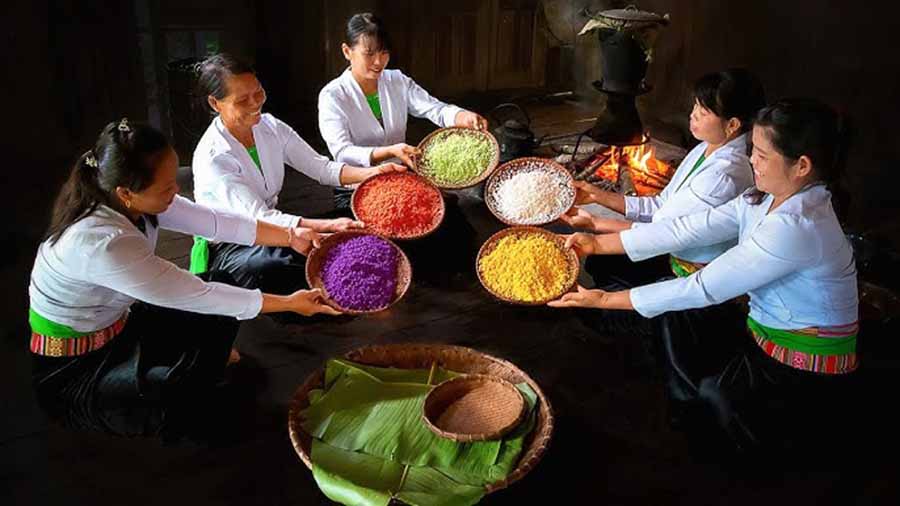
During the Lunar New Year, known as Tet, xoi holds a place of honor on the celebration table. It's a dish offered to ancestors, embodying respect and reverence. The vibrant colors and diverse flavors of xoi add to the festive spirit of these gatherings.
Xoi also plays a pivotal role in festivals, weddings, and engagement ceremonies. It symbolizes fertility, prosperity, and abundance, which are essential values in Vietnamese culture. Each grain of sticky rice in xoi signifies a wish for happiness and fortune.
Beyond its role in celebrations, xoi is part of daily life in Vietnam. People enjoy it as breakfast, a mid-day snack, or a light meal, reflecting its versatility and universal appeal. The cultural significance of xoi thus extends from sacred occasions to casual daily consumption.
Understanding Xoi: The Basics of Vietnamese Sticky Rice
Xoi, often known as sticky rice, is a staple in Vietnamese cuisine. The process of making xoi is simple yet requires attention to detail. Glutinous rice is the key ingredient, celebrated for its sticky and chewy texture.
First, the rice is soaked in water for several hours. This step ensures that the grains soften and absorb moisture. After soaking, the rice is steamed until it reaches the desired stickiness.
In Vietnam, xoi is enjoyed both as a main dish and as a side. Its versatility allows it to be sweet or savory, depending on the ingredients used. Common toppings include mung beans, coconut shavings, and meats.
Here is a basic breakdown of xoi preparation:
- Soaking: The rice needs to be soaked for several hours.
- Steaming: It is then steamed to achieve stickiness.
- Flavoring: Additional ingredients are added for flavor.
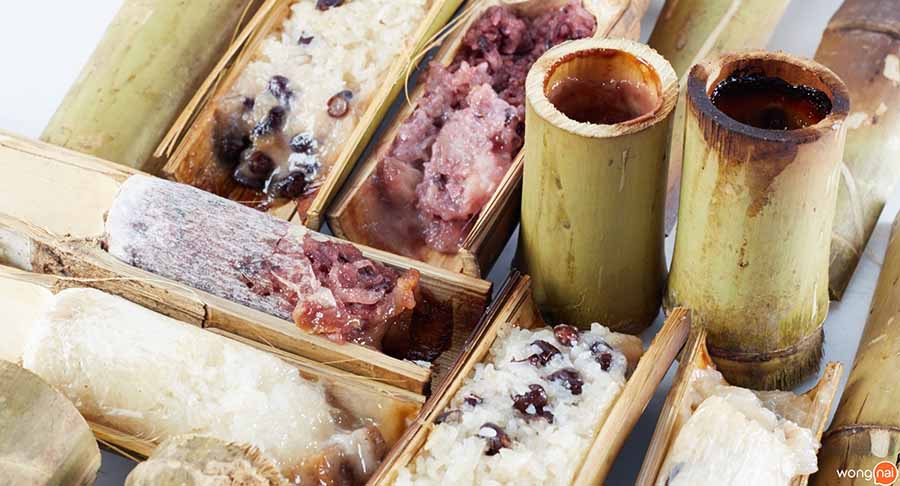
Xoi is more than just rice; it's a culinary canvas. Its adaptability allows chefs and home cooks alike to experiment with flavors. Each variant of xoi offers a unique taste, reflecting the creativity of Vietnamese cuisine.
The Different Varieties of Xoi
Vietnamese xoi comes in many forms, each with distinct flavors. The types of xoi can broadly be categorized into sweet and savory. Sweet xoi includes varieties infused with coconut milk and sugar for a rich, aromatic experience.
Savory xoi types feature protein-rich toppings like meats or beans. Each type reflects local traditions and available ingredients. Exploring xoi offers a glimpse into Vietnam's diverse culinary landscape.
Sweet Xoi Types
Sweet xoi delights the senses with its aromatic flavors. Coconut milk and sugar are common in these varieties, providing a rich taste. The colorful presentation makes sweet xoi visually appealing.
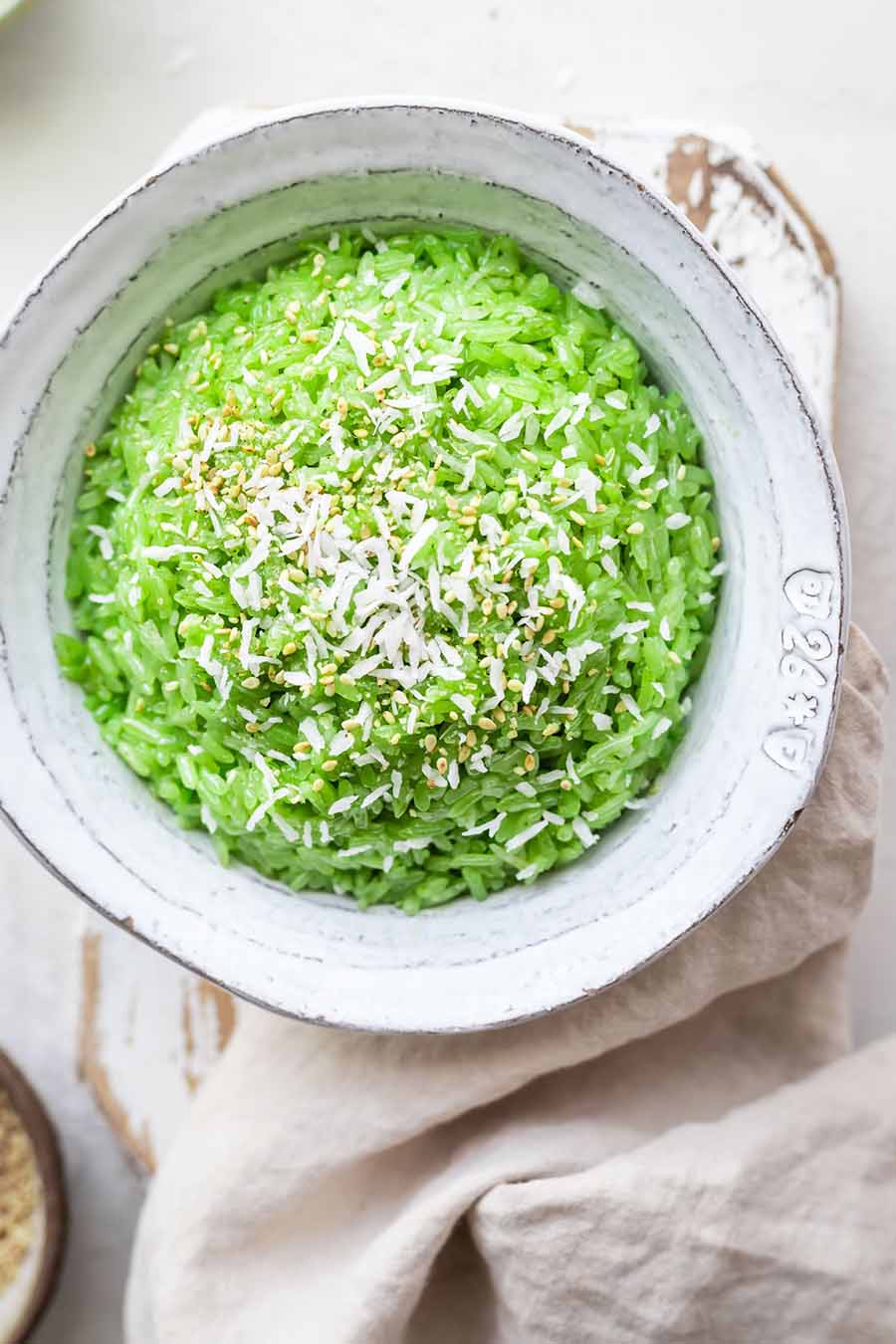
Xoi Ngot
Xoi Ngot is a traditional sweet dish in Vietnam. It's typically made with sugar, coconut milk, and often sesame seeds. This combination offers a sweet, rich flavor that is cherished as a dessert or snack.
Xoi Ngot is often enjoyed during Tet and other celebrations. Its sweetness symbolizes good fortune, making it a favored treat. The dish's simplicity is its strength, allowing the core ingredients to shine.
Xoi Gac
Xoi Gac is known for its vibrant red color. This hue comes from Gac fruit, which adds nutrients and a distinct flavor. The fruit not only colors the rice but also infuses it with a subtle aroma.
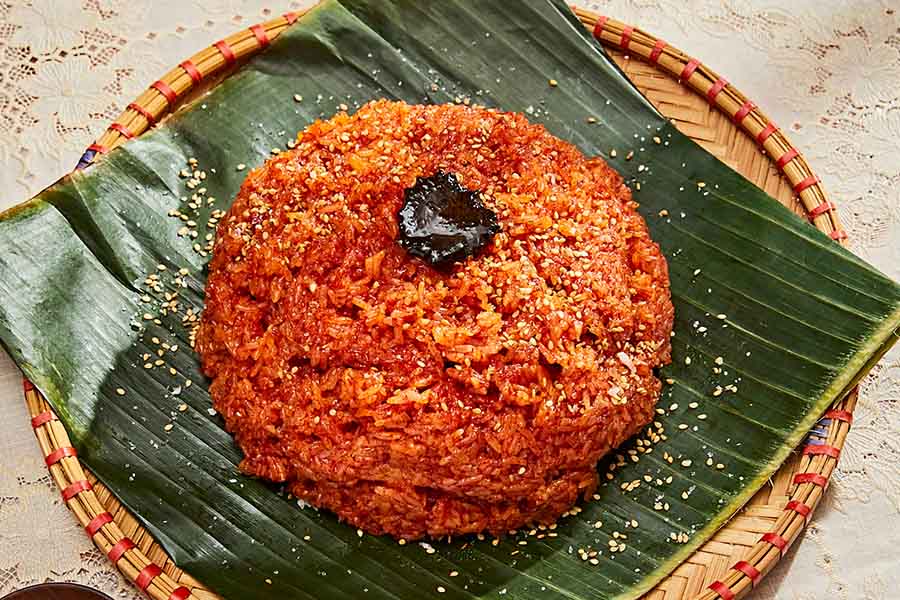
Traditionally, Xoi Gac is served at weddings and New Year celebrations. It symbolizes happiness and prosperity. With its striking appearance, it's as much a feast for the eyes as it is for the palate.
Xoi La Cam
Xoi La Cam delights with its natural purple color. This variety is colored with magenta plant leaves, providing both beauty and taste. The leaves impart a mild, fragrant aroma to the rice.
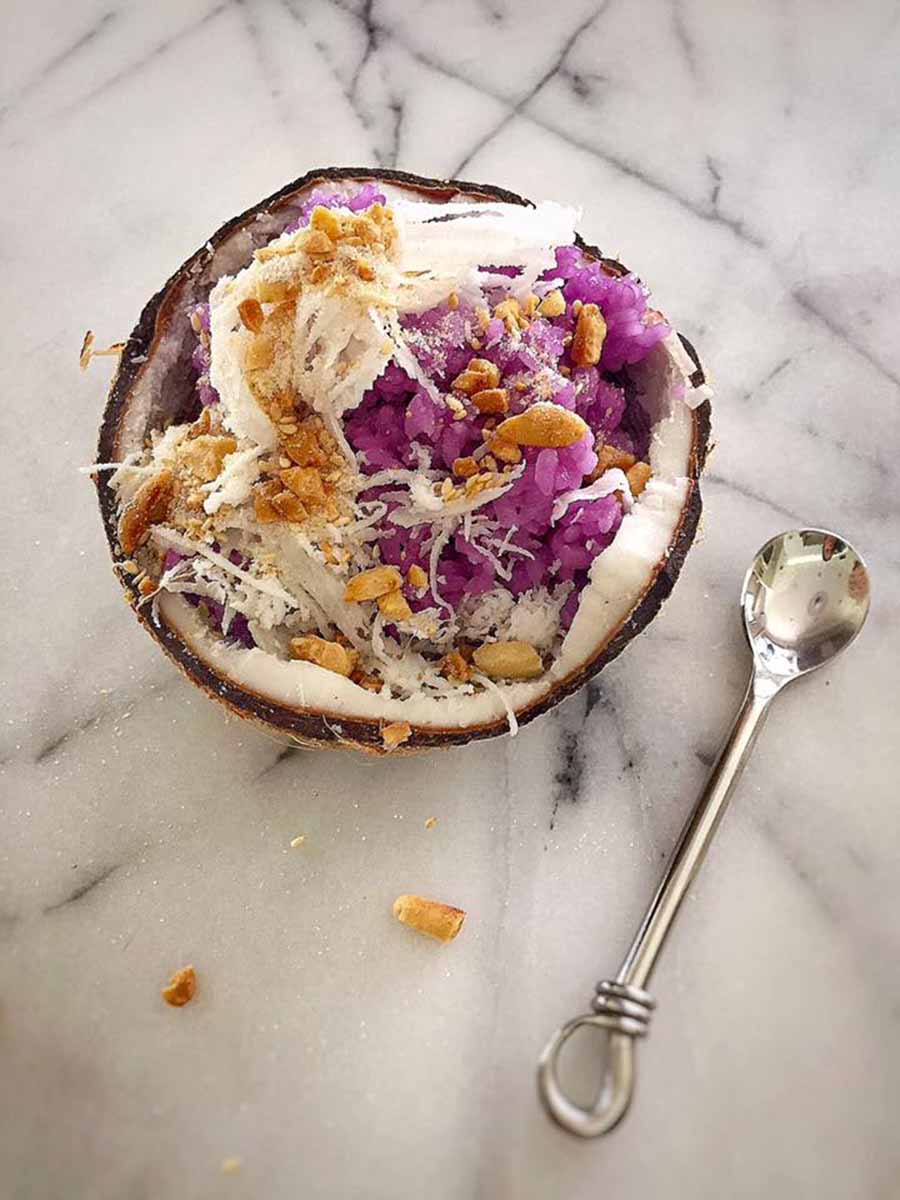
Xoi La Cam is as much about visual allure as flavor. It's often made during special occasions, where its vivid color enhances any feast. This type of xoi represents the harmony of nature and culinary craftsmanship.
Savory Xoi Types
Savory xoi offers heartier flavors with its array of toppings. It often includes protein-rich elements like meat or beans, balancing the sticky rice. These variations make a satisfying meal or side dish.
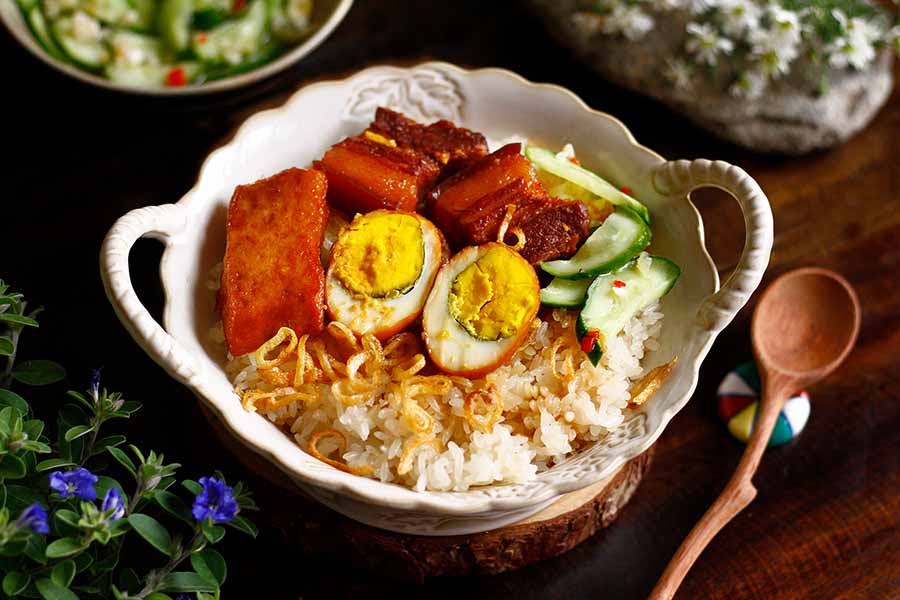
Xoi Man
Xoi Man is a beloved savory option in Vietnam. It typically features ingredients like Chinese sausage or shredded chicken. This variety is rich and satisfying, making it a popular choice for breakfast or lunch.

The combination of sticky rice and savory toppings creates a balanced dish. The flavors are bold, yet harmonious, providing a fulfilling meal. It's often enjoyed at street food stalls and local markets.
Xoi Vo
Xoi Vo incorporates mung beans, offering a nutty flavor. The beans are mixed into the rice, adding texture and taste. Coconut shavings are often added, enhancing the dish with sweetness.
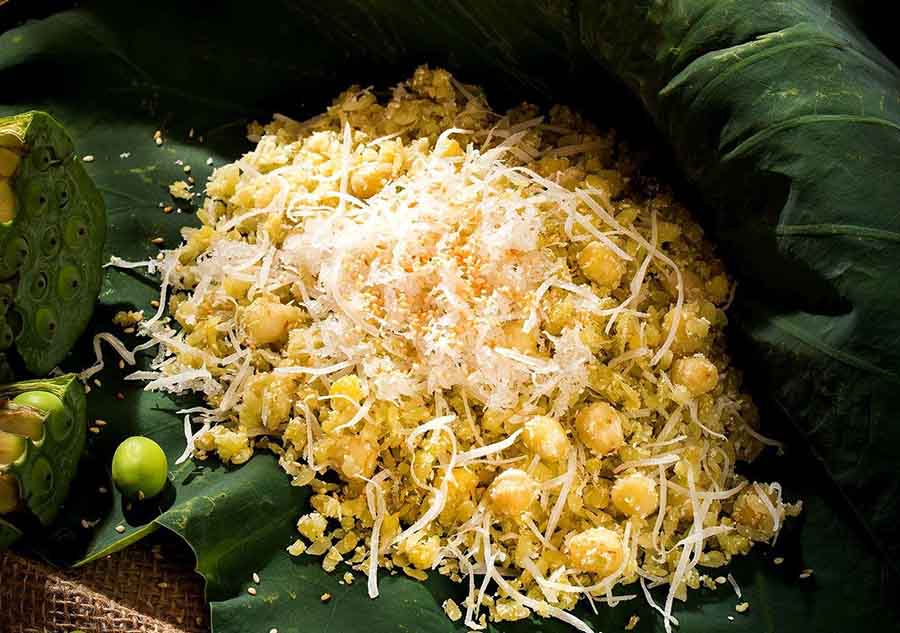
This type of xoi is a delightful balance of flavors. The combination of sweet coconut and savory beans makes it unique. It's commonly eaten as a snack or light meal throughout the day.
Xoi Pate
Xoi Pate is a fusion of Vietnamese and French flavors. It includes a layer of liver pate, offering a rich and decadent taste. The combination is unexpected yet delicious, appealing to adventurous palates.
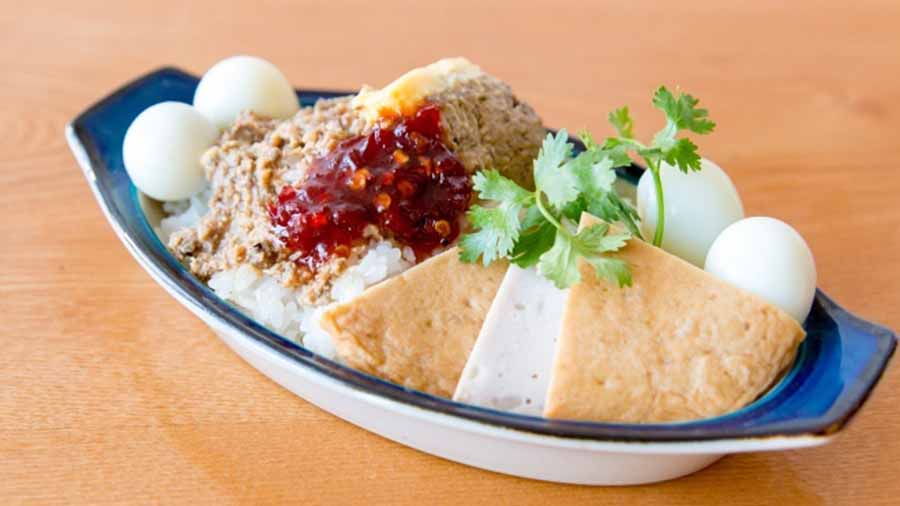
The creamy texture of pate complements the sticky rice. It's a unique take on traditional xoi, showcasing Vietnam's culinary innovation. This variety is an example of Vietnam's global culinary influences.
Regional Variations of Xoi
Vietnam's diverse regions each bring unique touches to xoi. Local ingredients and tastes influence these variations, creating a rich tapestry. From North to South, xoi reflects each area's culinary identity.
Northern Vietnam is known for simpler, earthy xoi varieties. These often include beans and seasonal vegetables. In contrast, Southern regions favor sweeter, richer versions, often using coconut milk.
Central Vietnam offers spicy and savory xoi types. The variety is a testament to Vietnam's culinary diversity. Each region’s xoi is a reflection of its history, climate, and cultural influences.
How to Enjoy Xoi: Serving and Pairing Suggestions
Enjoying xoi goes beyond savoring its flavors; it’s about experiencing Vietnamese culture. Xoi can be served as either a main dish or a delightful side. When served as a main meal, it’s often paired with complementary proteins.
For breakfast, xoi is typically enjoyed with a hot cup of Vietnamese tea. The beverage's subtle notes enhance the dish, creating a fulfilling start to the day. This pairing is a common yet beloved morning ritual in Vietnam.
At gatherings, xoi can be found alongside other traditional dishes. Dishes such as Vietnamese spring rolls or grilled meats perfectly match the rice's texture. Together, they provide a harmonious combination of flavors and styles.
Xoi as a Meal or Side Dish
Xoi adapts easily to various meal settings. As a main dish, it provides both sustenance and flavor complexity. Common main dish xoi comes with meats or savory vegetables, making it a hearty choice.
When used as a side, xoi complements dishes like grilled fish or pork. It balances these proteins with its neutral, sticky texture. This versatility makes xoi suitable for any part of a meal.
Xoi in Vietnamese Festivals and Ceremonies
In Vietnam, xoi plays a vital role in festivals. During the Lunar New Year, or Tet, xoi is a featured item. It symbolizes prosperity and happiness, shared among families and communities.
Xoi is also significant in ancestor worship ceremonies. It's an offering that honors and connects with the past. This role in ceremonies shows the spiritual importance of xoi in Vietnamese culture.
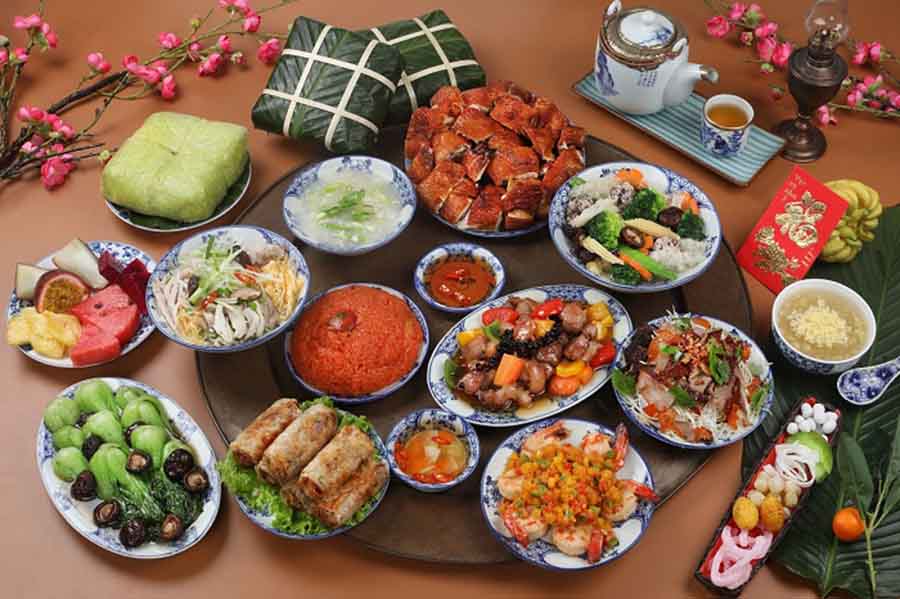
Where to Find Xoi: From Street Food to Restaurants
Xoi is a staple of Vietnamese cuisine, enjoyed by locals and travelers alike. In Vietnam, xoi can be found everywhere, from bustling street markets to upscale restaurants. Each venue offers a unique ambiance, enhancing the xoi experience.
Street vendors often serve xoi warm, packed in banana leaves for easy handling. This convenient packaging allows you to enjoy xoi on the go, making it a favorite snack. In contrast, restaurants may present more elaborate versions, complete with a selection of toppings.
Xoi for Travelers: A Must-Try Experience in Vietnam
For travelers exploring Vietnam, tasting xoi is a must. This simple dish is a gateway into the rich tapestry of Vietnamese culinary traditions. Sampling xoi from different regions showcases the diversity in flavors and ingredients across Vietnam.
Trying xoi enhances any Vietnam travel itinerary. It allows visitors to connect with local traditions through a shared culinary experience. From the bustling streets of Hanoi to the beaches of Da Nang, xoi offers a taste of Vietnam's vibrant culture.
Making Xoi at Home: Tips and Tricks
Creating xoi in your kitchen is both rewarding and simple. Start by selecting high-quality glutinous rice; this choice is crucial for authenticity. Soak the rice overnight to achieve the best texture.
Experiment with soaking times to find what works for your taste. Once ready, steam the rice rather than boiling it. This method preserves its sticky texture, a hallmark of authentic xoi.
Cooking Methods for Perfect Xoi
Achieving the perfect xoi involves mastering a few key techniques. Steaming in a bamboo basket is traditional and imparts a subtle earthy aroma. If that’s not available, a metal steamer works well.
For convenience, many use a rice cooker, allowing consistent results. Ensure the rice doesn’t get overly wet by keeping an eye on water levels. Perfectly cooked xoi should be sticky yet light.
Customizing Your Xoi: Toppings and Variations
Xoi offers a canvas for creativity in the kitchen. Enhance your xoi with simple toppings like sesame seeds or peanuts for extra texture. For a richer flavor, consider adding coconut milk or mung beans.
Varying ingredients like dried shrimp or chopped scallions can transform xoi from basic to bold. Don't hesitate to experiment with sweet or savory combinations. Personalizing your xoi makes each meal a culinary adventure.
Conclusion: The Enduring Appeal of Xoi
Xoi is a special dish from Vietnam that many people love. It has deep roots in the culture and tastes great. You can enjoy xoi at home or anywhere in the world. Each bite reminds you of tradition and brings happiness.
FAQs About Xoi and Vietnamese Cuisine
Many people have questions about xoi and Vietnamese cuisine. Here are some common queries answered for your curiosity.
- What is xoi?
- Xoi is a traditional Vietnamese sticky rice dish, versatile in flavors.
- Is xoi only sweet?
- No, xoi can be both sweet and savory.
- Where can I try xoi in Vietnam?
- Xoi is available at street food stalls and restaurants across Vietnam.
Exploring xoi offers a glimpse into Vietnam's rich food culture. Each type of xoi tells a unique culinary story. Enjoy discovering the diversity and flavors of this staple dish.
Kindly note that your request may be unrelated to the content of the article. However, here’s a revised version of the section that connects it to the culinary experience of xoi:
Simplify Your Travel with Vietnam Visa Online
Planning your trip to Vietnam to enjoy delicious xoi and other culinary delights? Make your travel experience seamless by applying for your Vietnam visa online. Our Vietnam Visa Online service makes it simple and fast to apply. This lets you focus on what really matters—experiencing the lively culture and delicious food of Vietnam, like the many kinds of xoi.
You can easily get your visa online from home. This way, you can enjoy xoi from street vendors and nice restaurants. Your visa will be sent to you by email, so you don't need to visit the embassy. Whether you are here for food or to learn about Vietnam's traditions, our service helps make your trip easy.
Don't let visa requirements hold you back from experiencing the wonders of Vietnam. Apply for your Vietnam visa online today and get ready to savor the delightful tastes of xoi and more, making your culinary exploration truly unforgettable!
Created: 2/4/2025 | Modified: 2/4/2025
